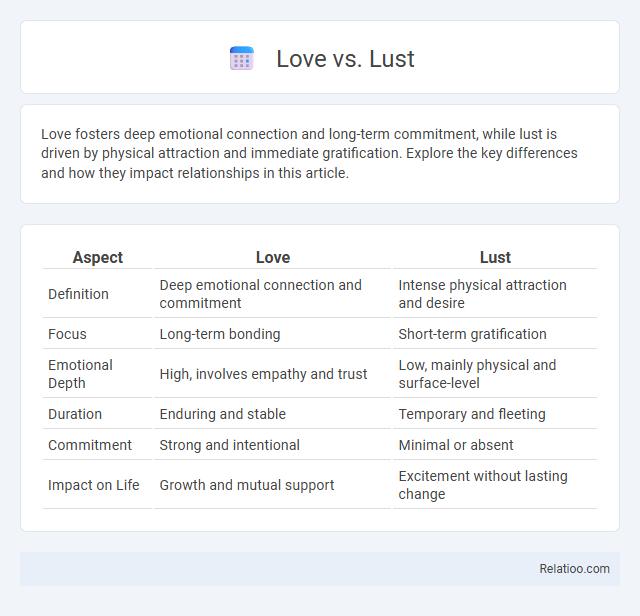Love fosters deep emotional connection and long-term commitment, while lust is driven by physical attraction and immediate gratification. Explore the key differences and how they impact relationships in this article.
Table of Comparison
| Aspect | Love | Lust |
|---|---|---|
| Definition | Deep emotional connection and commitment | Intense physical attraction and desire |
| Focus | Long-term bonding | Short-term gratification |
| Emotional Depth | High, involves empathy and trust | Low, mainly physical and surface-level |
| Duration | Enduring and stable | Temporary and fleeting |
| Commitment | Strong and intentional | Minimal or absent |
| Impact on Life | Growth and mutual support | Excitement without lasting change |
Understanding the Difference: Love vs Lust
Love involves deep emotional connection, trust, and long-term commitment, while lust is primarily driven by intense physical attraction and desire. Understanding the difference between love vs lust requires recognizing that love grows through shared experiences and emotional intimacy, whereas lust is often immediate and focused on physical pleasure. Distinguishing these feelings helps build healthier relationships and prevents confusion between genuine affection and temporary attraction.
The Psychology Behind Love and Lust
The psychology behind love and lust reveals distinct neurological and emotional processes, with love activating deep attachment centers in the brain such as the ventral tegmental area and caudate nucleus, while lust primarily engages the hypothalamus driving sexual desire. You experience love through long-term bonding hormones like oxytocin and vasopressin, fostering trust and commitment, whereas lust is fueled by dopamine and testosterone, triggering intense but often short-lived physical attraction. Understanding these differences helps clarify how emotions evolve from initial passion to profound connection, shaping your relationship dynamics.
Key Signs of Genuine Love
Genuine love is characterized by deep emotional connection, trust, and selfless care for your partner's well-being, unlike lust, which centers on physical attraction and temporary desire. Key signs of true love include consistent support during difficult times, respectful communication, and prioritizing your partner's happiness alongside your own. Understanding these distinctions helps you recognize and nurture authentic, lasting relationships beyond surface-level infatuation.
How Lust Manifests in Relationships
Lust manifests in relationships through intense physical attraction and a strong desire for immediate gratification, often overshadowing emotional connection and long-term commitment. This primal urge can lead to impulsive behaviors driven by dopamine and testosterone, creating a temporary high rather than lasting intimacy. Understanding how lust influences your feelings helps differentiate it from deeper love, fostering more mindful and meaningful connections.
Emotional Depth: Love’s Lasting Impact
Love embodies profound emotional depth, fostering trust, empathy, and long-term commitment that nurtures personal growth and resilience. Lust tends to be driven by physical attraction and immediate gratification, lacking the enduring emotional connection and stability found in love. The lasting impact of true love creates meaningful bonds that withstand challenges and evolve over time, distinguishing it fundamentally from fleeting desire or infatuation.
Physical Attraction: The Role of Lust
Physical attraction plays a central role in lust, characterized by intense desire and sensory stimulation rather than emotional connection. Lust triggers the release of hormones like dopamine and testosterone, fueling passion and immediate gratification without deeper attachment. In contrast, love integrates physical attraction with emotional intimacy, trust, and long-term commitment, distinguishing it from the primarily corporeal nature of lust.
Can Lust Evolve Into Love?
Lust, characterized by intense physical attraction and desire, can serve as the initial spark in a relationship but often lacks the deep emotional connection found in love. Over time, as partners share experiences, build trust, and develop emotional intimacy, lust can evolve into love, which encompasses commitment, care, and long-term affection. Neurochemical changes, including shifts from dopamine-driven desire to oxytocin-fueled bonding, support this transformation from lust to enduring love.
Mistaking Lust for Love: Common Pitfalls
Mistaking lust for love often leads to emotional confusion as intense physical attraction is falsely interpreted as deep emotional connection. This pitfall causes individuals to overlook crucial signs of compatibility, resulting in rushed or unhealthy relationships. Recognizing the differences between lust's impulsive nature and love's enduring bond is essential to avoid heartbreak and foster genuine intimacy.
Navigating Relationships: Balancing Love and Lust
Navigating relationships requires understanding the distinct emotional and physical dimensions of love and lust, where love involves deep emotional connection and long-term commitment, while lust is driven by intense physical attraction and desire. Balancing these elements ensures a healthy relationship dynamic, as excessive lust without love can lead to superficial bonds, whereas love without passion may cause emotional stagnation. Cultivating mutual respect, clear communication, and emotional intimacy promotes a sustainable relationship that harmonizes both love's depth and lust's vitality.
Building Healthy Connections: Prioritizing Love Over Lust
Building healthy connections requires prioritizing love, which fosters deep emotional bonds and mutual respect, over lust, characterized by fleeting physical attraction and instant gratification. Love emphasizes long-term commitment, trust, and understanding, creating a foundation for sustainable relationships, whereas lust often leads to superficial interactions that lack emotional depth. Focusing on love encourages authentic communication and emotional support, essential for nurturing lasting, meaningful partnerships.

Infographic: Love vs Lust
 relatioo.com
relatioo.com